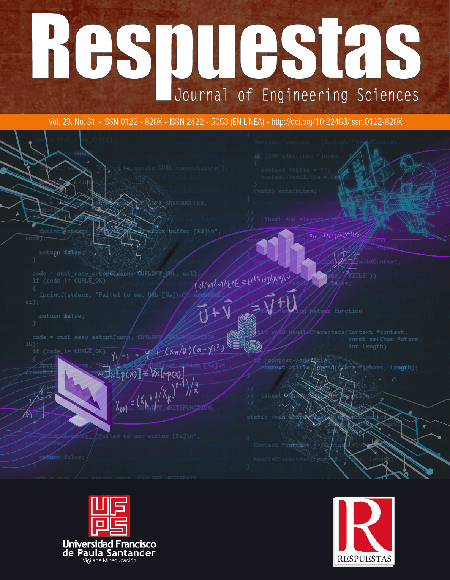Extraction of DNA from bacteria preserved in the strain bank of the Universidad Francisco de Paula Santander head office Campos Elíseos
Extracción de ADN de bacterias conservadas en el banco de cepas de la Universidad Francisco de Paula Santander sede Campos Elíseos
Main Article Content
Currently, the identification of bacteria is done with classical techniques based on the phenotypic characterization at macroscopic
and microscopic level, however, this method is not reliable and does not allow knowing the true identity of the microorganism
under study. For this reason it is necessary to carry out an identification at the molecular level that allows us to know with
certainty the genus and species. The objective of this work was to standardize a method of DNA extraction for Gram-negative
and Gram-positive bacteria according to the chemical characterization, which allowed obtaining good quality DNA for the
amplification of a specific region of interest. Two extraction methods were evaluated, the Wilson protocol and the Wizzard
extraction kit (Promega), the two methods were differentiated in the quantification by NanoDrop and visualized by means of a
0.8% agarose gel electrophoresis using the Intercalante Gel red. According to Wilson's protocol, only DNA from Gram negative
bacteria of good quality was obtained, and the ratio 260/280 in the nanodrop (1.8-2). While the Wizzard Extraction Kit allowed
to obtain DNA for Gram positive and negative bacteria. Better DNA concentrations were obtained with the Wilson protocol, and
it was not possible to obtain DNA from Gram positive bacteria. For this case, the Wizzard kit was an unlimited method to extract
DNA of any kind, according to the reasons mentioned above, the protocol that reduces costs in the laboratory and is the most
convenient to extract the DNA from Gram negative bacteria is the one proposed by Wilson.
Keywords: Nucleic acids,Bacillus thurigiensis,E. coli,Microorganisms
Downloads
Article Details
L. Suárez, “Extracción y purificación del ADN de Moniliophthora roreri hongo que ataca el cacao, en norte de santander”, Respuestas, vol. 10, no. 2, pp. 4-8, 2005.
A. Espitia, Identificación molecular mediante ITS de los fitopatógenos Fusarium sp., Alternaria sp., Rhizopus sp., Aspergillus sp., Curvularia sp., pertenecientes al banco de cepas de la Universidad Francisco De Paula Santander, Sede Campos Elíseos. Trabajo de grado. 2018.
L. Suárez y F. Peñaranda. Identificación molecular de los aislamientos de hongos biocontroladores conservados en el banco de cepas de la Facultad de Ciencias Agrarias y del Ambiente de la Universidad Francisco de Paula Santander. Proyecto FINU 042–2016. 2018.
L. Suárez, “Aislamiento e identificación de Moniliophthora roreri causante de la moniliasis en municipios del nororiente Colombiano”, Respuestas, vol. 11, no. 1, pp. 3-8, 2006.
L. Suárez y C. Cabrales, “Identificación de especies nativas de Trichoderma sp, y Bacillus. Evaluación de su potencial antagonista in vitro frente al hongo fitopatógeno nativo Moniliophthora roreri en el departamento de Norte de Santander”, Respuestas, vol. 13, no. 1, pp. 45–56, 2008.
G. Bou, A. Fernández, C. Garcia, J. Sáenz, y S. Valdezcate, Métodos de identificación bacteriana en el laboratorio de microbilogía. Enfermedades infecciosas y microbiología clínica, 601-608. 2011. doi:10.1016/j.eimc.2011.03.012
M. Godoy, L. Orozco, C. Hernández, O. DaMa-tac, J. De Waard, y S. González, "Identificación de micobacterias no tuberculosas: comparación de métodos bioquímicos y moleculares", Revista de la Sociedad Venezolana de Microbiología, pp. 96-104, 2008.
E. Rubio, Caracterización molecular y funcional de bacterias del género Azotobacter aisladas de suelos de la República Argentina. El rol de las auxinas en la respuesta a la inoculación de trigo. Buenos Aires: Tesis de Maestría. 2003
H. Yoshikawa, F. Dogruman-Al, F. Dogruman-Ai, S. Turk, S. Kustimur, N. Balaban, et al, "Evaluation of DNA extraction kits for molecular diagnosis of human Blastocystis subtypes from fecal samples", Parasitol Res, vol. 109, no. 4, pp. 1045-50, 2011.
D. Singka, L. Kumdhitiahutsawakul, P. Rekkriangkrai and W. Pathom-aree, "A simple method for DNA extraction from activated sludge", Chiang Mai J. Sci, vol. 39, pp. 111–118, 2012.
M.E. Gabor, E.J de Vries, D.B Janssen, "Efficient recovery of environmental DNA for expression cloning by indirect extraction methods", FEMS Microbiol. Ecol. vol. 44, pp. 153–163, 2003.
V. Ramachandran, P. Ismail, J. Stanslas and N. Shamsu-din, " Analysis of renin-angiotensin aldosterone system gene polymorphisms in Malaysian essential hypertensive and type 2 diabetic subjects. Cardiovasc" Diabetol, vol. 8, no. 11, pp. 2009.
K. Wilson, Preparation of genomic DNA from bacteria, in Current Protocols in Molecular Biology (Ausubel, F.M., Brent, R.,Kingston, R.E., Moore, D.D., Seidman, J.G., Smith, J.A., et al.), Wiley, New York, pp. 241.-245, 1987.
L. Alejo, M. Aragón y A. Cornejo, "Extracción y purificación de ADN. Herramientas moleculares aplicadas en ecología. 1-26 p. 2008
M. Coolen. 7000 years of Emiliania huxleyi viruses in the Black Sea. Science. 333:451-2. 2011
S. Yuan, D. Cohen, J. Ravel, Z. Abdo, and L. Forne, "Evaluation of methods for the extraction and purifi-cation of DNA from the human microbiome", PLoS ONE, 2012.
S. Claassen, E. du Toit, M. Kaba, C. Moodley, H. Zar, M. Nicol, "A comparison of the efficiency of five different commercial DNA extraction kits for extraction of DNA from faecal samples", J Microbiol Methods, vol. 94, no. 2, pp. 103-110, 2013.
S.J. McIlroy, K. Porter, R.J Seviour and D. Tillett, "Extraction nucleic acid from activated sludge which reflect community population diversity. A. Van Leeuw". Antonie van Leeuwenhoek, vol. 96, no. 4, pp. 593–605, 2009. http://dx.doi.or-g/10.1007/s10482-009-9374-z.
R.L Meyer, A.M Saunders, and L.L Blackall, "Putative glycogen-accumulating organisms belonging to the Alphaproteobacteria identified through rRNA-based stable isotope probing", Microbiology, vol. 152, no. 2, pp. 419–429, 2006
J. Ahn, S. Schroeder, M. Beer, S. McIlroy, R.C Bayly, J.W May, G. Vasiliadis, R.J Seviour, "Ecology of the microbial community removing phosphate from wastewater under continuously aerobic conditions in a sequencing batch reactor", Appl Environ Microbiol, vol. 73, no. 7, pp. 2257–2270, 2007.







